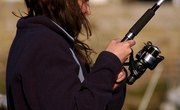Fishing can be a rewarding sport for people of all ages and backgrounds. When fishing with live or artificial bait, it is important to securely attach the right hook and enough weight to the end of the line. Experienced fishermen develop their own style and may use a different method for preparing the line. However, beginners can have just as much luck with a simple rig.
Items you will need
Fishing pole with line
Hook
Weight
Needle-nose pliers
Consider the size of the fish you will be attempting to catch. This will help you determine the size of the hook that will be needed. A vast variety of hooks and weights are available in the fishing market, and choosing the right combination with which to rig your pole comes with experience. The average freshwater hook is between size 6 and 10. For now, remember that a hook that is too small will be easier for the target fish to shake off in the water, and a hook that is too large will not fit in the mouth of the fish.
Select a proper amount of weight for the water depth and current. A heavy line is more likely to get caught on the bottom of the waterway. Too little or no weight on the end of the line will cause the line to float at the surface or be quickly swept away by the current. An average of one or two weights will be needed. A balance of the right amount of weight will present the hook and bait at a level where the fish can easily pursue it.
Give the fishing line some slack, and tie the hook to the line. TakeMeFishing.org, an informative website devoted to fishing, recommends using the improved clinch knot. To begin the clinch knot, pull the loose end of the line through the eye of your hook. Next, wrap the loose end of the fishing line at least five times around the line going into the hook. Finally, guide the loose end of the line through the loop next to the eye of the hook. Pull the knot tight.
Use a nail clipper or fishing line scissors to delicately trim the excess line sticking out of the knot. Do not burn the excess line off because this weakens the fishing line. Test your knot by pulling lightly on the hook. Most lines aren't fashioned to withstand the strength of a human, so tug gently to test your knot.
Attach one or two weights to the fishing line. The U.S. Fish and Wildlife Service suggests placing the weighs 6 to 12 inches above the hook. Most weights are incredibly easy to attach with the use of needle-nose pliers. Hold the weight so that the line runs through its crevice. Once in place, squeeze this crevice shut around the line with your pliers.
Bait the hook and test your rig by casting it into the water. If you are constantly getting caught on the bottom, there is too much weight on the line, and if your line won't sink very far into the water, you are using too little weight. Adjust accordingly.
Tips
- A fishing knot is stronger when it is wet first. Use your saliva or water to moisten at least 6 inches of the end of the line.
References
Tips
- A fishing knot is stronger when it is wet first. Use your saliva or water to moisten at least 6 inches of the end of the line.
Writer Bio
Kate Zimmerman (pseudonym) has attended college for business management and writing. Her work can be found on multiple websites, including Golflink, eHow, Travel Trails and Answerbag. Her articles cover a wide variety of topics such as health, hunting, fishing, nature, and many more.



